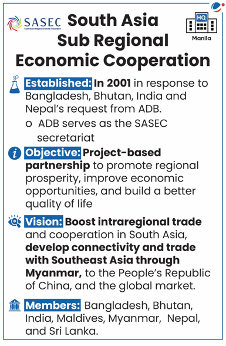Why in the news?
PM laid the foundation stone of multiple projects in Assam as part of the SASEC corridor connectivity.
More on News
- It includes projects worth over Rs 3400 crore, under which 43 roads including 38 bridges will be upgraded.
- It also includes four lane projects which will improve the connectivity to Itanagar and boost the overall economic development of the region.

Focus areas of SASEC
There are mainly four pillars of SASEC cooperation which include: -
- SASEC Transport Sector Strategy: Create multimodal transport networks and logistics facilities to increase intraregional trade and boost growth
- Support the strategic priorities of the SAARC at the inter-regional level
- SASEC Trade Facilitation: Implement SASEC Trade Facilitation Strategic Framework (2014-18) focusing on customs modernization, cross-border facilities improvement
- Support the strategic priorities of South Asia Free Trade Agreement cooperation framework
- SASEC Energy Sector Strategy: Improve cross-border electricity transmission connectivity
- Increase power trade, cooperation in energy efficiency and clean power development
- Economic Corridor Development Strategy: In 2016, countries approved the SASEC Operational Plan 2016-2025, introducing Economic Corridor Development as a fourth sectoral area of focus
- Prioritize construction of economic corridors with potential cross-border linkages
- Optimize opportunities to bring innovation into public-private partnerships.
Significance of SASEC for India
- Link between South Asia and Southeast Asia: Road corridors in Myanmar provide India a link between South and South East Asia.
- Additional gateways to the landlocked North Eastern region with development of the ports in Myanmar.
- Development of multi-modal connectivity between North Eastern region of India, Bangladesh and Myanmar has the potential of unleashing tremendous economic energy in the sub-region.
- SASEC has been instrumental in implementing the India-Myanmar-Thailand Trilateral Highway, which will run from Moreh in Manipur to Mae Sot in Thailand via Myanmar.
- It can also act as an alternative to One Belt One Road initiative of China in the region.
- Moreover, the project being a part of the Great Asian Highway developed under United Nations Economic and Social Commission for Asia and the Pacific (UNESCAP) will strengthen India’s position at the global level.
Challenges of SASEC
- Lack of effective cross-border transport infrastructure in South Asia minimizes potential of trade
- Lack of modern automated border procedures lead to higher costs, more time for goods, vehicles and traders to cross borders
- Underutilized intra-regional trade in South Asia which comprises of merely ~5% whereas as compared to ASEAN region where intraregional trade makes up 25% (World Bank).
- Red tapism leads to barriers such as lengthy administrative procedures, unnecessary documentation and absence of harmonized trade regulations
- Lack of cross-border energy interconnection infrastructure such as national power grids to ensure efficient and reliable energy supplies.
- Current industrial bases in South Asia are unconnected to regional and global value chains, which severely hinders the capacity to optimize effective industrialization processes.
- Low FDI in South Asia due to inadequate infrastructure connectivity and ‘business unfriendly’ regulatory and institutional frameworks
Way Forward
- Improving the efficiency of regional transport and trade facilitation through Multimodal Transport Connectivity could lead to increased intraregional trade within South Asia and also with rest of the world.
- Upgrading infrastructure at border-crossing points with tools of customs modernization and harmonization should be prioritised to meet the international standards.
- Implement policy, regulatory, and institutional reforms for to reduce time and make the trade cheaper and faster
- Regional Energy Cooperation can strengthen energy security during external shocks and also improve access and development of renewable energy resources.
- Strengthening existing value chains related to supply chain, trading and logistics capacities and connect them to value chains in neighbouring countries.
- Synchronizing and integrating urbanization and industrialization to boost productivity and living standards in South Asia.



